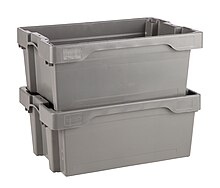Stack and nest container
Stack and nest containers, also two-phase containers or space-saving containers, are transport or storage containers made of plastic . It is possible to nest the containers into one another when empty, which saves volume when storing or returning the empty boxes. For this, the container on top is rotated horizontally by 180 degrees.
description
Stack and nest containers are rigid containers, they cannot be folded up. They are in contrast to nestable containersStackable without additional accessories, since the bottom of an upper container is held in the separate inner edge of the lower container. The upper edge of the container is turned over and forms a circumferential grip strip. A special design feature of this container shape is the asymmetrically arranged ribs or columns running from the edge to the bottom. In conjunction with the tapering side walls, this means that the containers can slide into one another after a 180 degree rotation along their side walls. The edge of the upper container comes to rest on the edge of the lower one. With this construction, the volume reduction is only effective from the second container, so it is significantly less than z. B. with comparable collapsible or collapsible containers. The side walls of the stack and nest containers are usually closed. Due to the rigid construction, they are highly resilient, both in terms of their filling and the loads in the stack. They are also very torsion-resistant . Due to their conical side walls, however, stack and nest containers have approx. 20% less volume than comparable containers with vertical side walls. Stack and nest containers are manufactured from plastic granulate using an injection molding process. For this purpose, heat-liquefied plastic is pressed into metal molds under high pressure. Usual stack and nest containers are manufactured in various basic dimensions up to 800 mm × 600 mm.
use
Stack and nest containers belong to the group of small load carriers (KLT) that cannot be driven under . They are an older design of the volume-reducible container. Nevertheless, they are still widely used and are constantly being further developed. Stack and nest containers are often used on automatic conveyor systems such as roller conveyors or conveyor belts. They are also the most widely used container type in the courier industry .
Individual evidence
- ↑ youtube video that shows how stack and nest containers work. Retrieved December 12, 2011.
- ↑ H. Martin: Transport and warehouse logistics: planning, structure, control and costs of intralogistics systems , Wiesbaden 2009, p. 62.
- ↑ See European patents: EP 1634815 or EP 1730042 B1 .
- ^ R. Vahrenkamp: Logistik: Management und Strategien , Munich 2007, p. 204.
